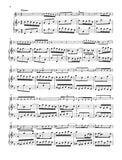Sonata in F Major, BWV 1038 - OB/PN or VLN/PN
Composer: Bach, J.S.
Publisher: Amadeus (Switzerland)
Edition: 57641
$24.00
for oboe da caccia (or violin) and piano (obligato cembalo)
by Johann Sebastian Bach (1685-1750) - German Baroque composer
Edited by Kurt Meier
The source for this sonata, published for the first time in this scoring, was the well-known Trio Sonata in G major for flute, violin, and basso continuo, BWV 1038. This probably resulted from composition lessons within the Bach home: a pupil would add two treble voices to a given bass, with the teacher offering help where needed. The fair copy in Bach's hand suggests he was satisfied with the result. Bach's pupil may have been Carl Philipp Emanuel, who wrote five sonatas for this scoring during the same year 1731.
Following contemporary practice, Trio Sonatas were often arranged for a solo instrument and harpsichord obligato. The Trio Sonata in G Major for two flutes and Continuo, BWV 1039m of which there exists a (probably) later version for Viola da gamba and harpsichord obligato, BWV 1027, is a good example.
The Sonata presented here in a version for oboe da caccia and harpsichord obligato. Bach wrote the violin part in scordatura: the two top strings are tuned down by a major second each. This alters the proportions of the overtones, producing a softer timbre which perfectly corresponds to the Oboe da caccia. Transposition to F Major produces an ideal key (oboe da caccia is in F) and the required range is too extensive in a few cases only, a problem solved by octavation. The few double stops are unimportant for the melody. For the rest, we follow the urtext where notes and articulation is concerned. The combination of flute and oboe da caccia, often found in JS Bach's Cantatas and Oratorios, would also justify a rendering by these two instruments and basso continuo.
This edition comes with:
- One solo part for oboe da caccia
- One alternate solo part for violin (or oboe)
- One fully realized keyboard part











Share this item: